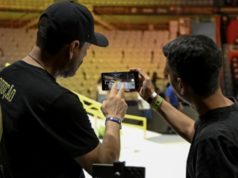Radio-frequency identification (RFID) tags have proved useful for things like tracking inventory, but they haven’t worked in games and other applications that require fast information processing — until now. A team of researchers from Disney and Carnegie Mellon University have developed a way to use RFID tags for near-real-time interactions with a wide variety of objects.
The new system, called RapID, uses probabilistic models to enable computers to quickly read the movements of RFID-enabled objects to play games and identify other real-world actions. In one demonstration, researchers showed how RapID can be used to integrate tic-tac-toe moves on a physical game board with a display on a computer screen.
Because RFID tags are passive devices that don’t require batteries or wiring — the electronic information they contain is detected and interpreted by a nearby RFID reader — they could be applied to, printed onto or drawn on almost any object, from a piece of paper to a human. That means with the method developed by Disney and Carnegie Mellon researchers, almost anything could be made “smart” with an inexpensive RFID tag.
Low-Cost, Real-Time Interactivity
RFID tags, which might cost around 10 cents, could make it possible to add interactivity to paper objects, craft materials and many other things, Alanson Sample, a research scientist at Disney Research, said in an article on Carnegie Mellon’s Web site.
“You can create interactive objects that are essentially disposable and perhaps even recyclable,” Scott Hudson, a professor at Carnegie Mellon’s Human-Computer Interaction Institute, said in the article.
The researchers presented their findings earlier this week at the Conference on Human Factors in Computing in San Jose. A video accompanying the research article on the Disney Research site showed RFID tags being used to display various real-world actions — moves on a tic-tac-toe board, slider motions on Pong-like controllers, movements of a hand-held spaceship toy — on a nearby computer monitor.
“[A] designer can use RFID tags to add inexpensive, wireless, low-footprint, batteryless, low-latency input sensing to objects,” the team wrote in their research paper. “By making it easy to add RFID-based sensing to objects, RapID enables the design of new, custom interactive objects with a very fast development cycle.”
‘Fast-Enough, Good-Enough’ Applications
Why is Disney researching applications for RFID tags? For one answer, look no further than the company’s MagicBands that were introduced in 2013.
The wristbands, now available for customization in all kinds of colors and styles, use RFID tags to let theme park and hotel visitors check into rides and restaurants, unlock rooms and access personalized experiences across Disney properties.
Forrester Research Inc. analyst Frank Gillett told us the new RFID system described by Disney and Carnegie Mellon could have a broad variety of applications. He said the technology could work with toys, books, cereal boxes and household objects.
For example, IKEA could in theory apply the technology to its assemble-yourself furniture and combine that with an app to make its products easier for people to put together, he said. The “fast-enough, good-enough” interactivity of RFID tags wouldn’t be likely to replace technologies found in, say, smartphones, but it could have wide application in many other uses, Gillett said.
If Disney has had this research available for some time, it’s possible that real-world applications of the technology could be available soon, he said. However, it’s likely the earliest products to feature such smart RFID tech would probably be simple ones over the next few months, while more complex applications aren’t likely to hit the market for a year or two yet, Gillett added.
Image Credit: Screenshot of RapID (pictured above) via Carnegie Mellon.







